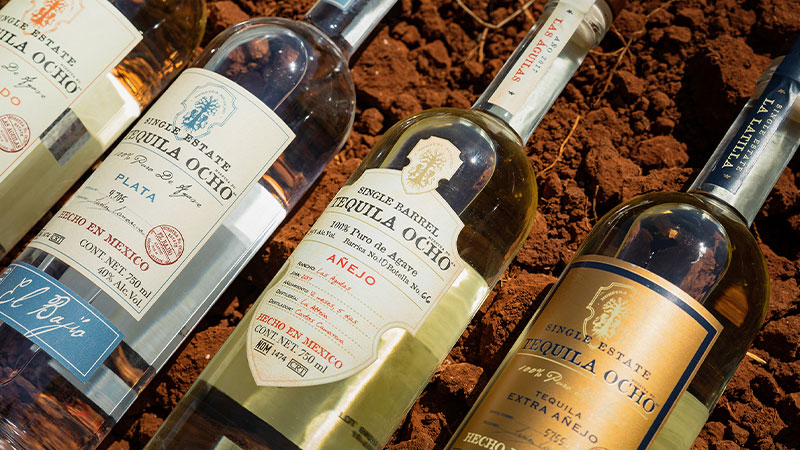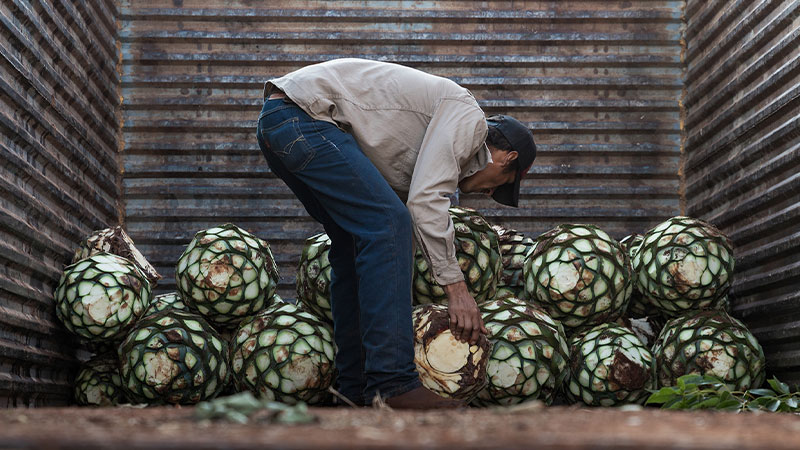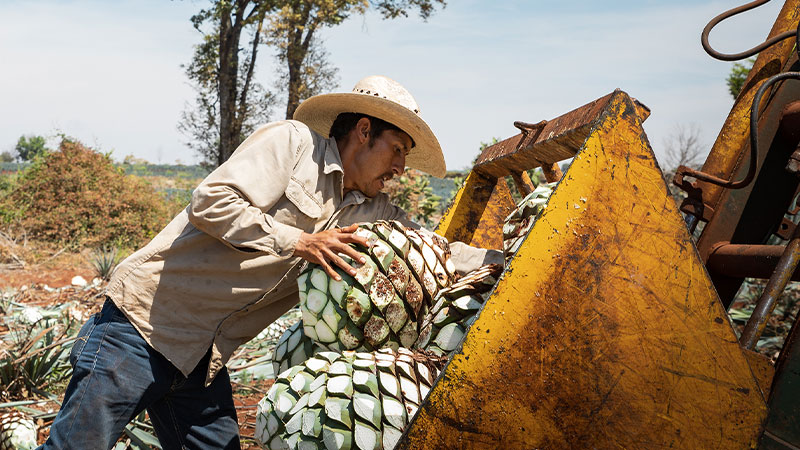
Scattered through distinct ranchos in the Highlands of Jalisco are clusters of Blue Weber agaves, a few flowering. Each agave field has a name, an altitude, and a microclimate all its own.
All of these agaves are owned by the Camerena family, which started making 100 percent Blue Weber agave tequila generations ago. Today, the Camerenas produce the single estate Tequila Ocho. Each harvest of agaves used for Tequila Ocho originates from a single field, and each tequila expression — Plata (or Blanco), Reposado, Añejo, Extra Añejo — features a distinct nuance in its flavor profile, reflective of its source — where and how those agave plants grew.
Tequila Ocho, the brainchild of Carlos Camerenas and the late Tomas Estes, proudly maintains a commitment to sustainability that impacts tequila creation, from the field to the glass. Tequila Ocho holds onto tradition through natural production methods that give back to the earth and its local community in Mexico. This harmonious relationship with the earth is vital not only for contemporary tequila-making but also for the health of our planet overall.
This connection to the land earned the spirit the 2017 Tales of the Cocktail Sustainable Spirit Award. Here are the pillars that uphold Tequila Ocho’s continuous commitment to sustainability.
Social Sustainability
The backbone of Tequila Ocho is the people who dedicate their lives to producing this spirit. The jimadores, for example, work with their hands and tools to harvest agaves the traditional way, expertly identifying and only harvesting the mature plants.
The idea of man’s value over that of the machine runs throughout the process of creating Tequila Ocho. Many of the Los Alambiques distillery’s team members are second- or third-generation employees, several generations of fathers and grandfathers committed to the meaningful work of making sustainable tequila. The family business prioritizes employees over efficiency by eschewing machinery that could sacrifice jobs, and instead enlists a team of more than 100 employees to handle each bottle of Tequila Ocho.
Ecological Sustainability
Each bottle of Tequila Ocho starts and ends with the local landscape to keep the community close. The agaves are sourced from within and around the “golden triangle” of Arandas, an area of Los Altos de Jalisco in Mexico commonly known for growing some of the world’s best agaves.
All tequila production requires a lot of water, which is why it’s so important that the water used for production at Los Alambiques Distillery is recycled. Tequila production also produces significant amounts of vinaza, a highly acidic, toxic liquid waste that, if released untreated, can destroy soil, kill life, and contaminate bodies of water. Tequila Ocho transforms leftover agave residues and vinaza into organic compost that can safely irrigate the agave fields without threatening the local landscape. Some of the leftover Tequila Ocho packaging materials are recycled.
Moving forward, Tequila Ocho plans to expand its ecological efforts by potentially reducing carbon dioxide emissions through solar energy.
Production of Agave
In keeping with the Tequila Ocho name and the family’s belief in the mystical elements of the number eight, the Blue Weber agaves used to make the spirit take around eight years to ripen before harvest. Tequila Ocho never harvests young, unripe agaves, despite the demand for tequila due to the spirit’s growing popularity. Carlos and his team only harvest overripe agave, for its high sugar content, which ultimately will produce high-quality tequila.
The Camarena family has full stewardship over the agave farmlands. They choose not to use any chemical herbicides, fertilizers, or pesticides in the fields, opting instead for organic compost and manure fertilizer. The agaves are sprayed with a fungus that naturally combats pests without harming the plants. Crops are rotated to keep the soil healthy and nutrient-rich, and the land is given time to renew and be restored between agave growth cycles.
Long-Term Sustainability and Bat-Friendly Project
In the tequila world, there’s a lot of buzz around the issue of the long-term sustainability of the Blue Weber agave species. The Blue Weber agaves used to make tequila are clones, meaning they’re nearly genetically identical to one another. They’re resilient in the same ways, but also fragile in the same ways, meaning a threat — like pests, bacteria, or disease — to one agave is a threat to all.
For the Tequila Ocho family, sustainability is not just a buzzword. Tequila Ocho was one of the early distillers to take part in the Bat Friendly project, which is overseen by the Tequila Interchange Project with support from the National University of Mexico and continued research by several scientists. The program aims to diversify the Blue Weber agave by allowing the quiote, or stalks used for reproduction, to flower in at least 5 percent of the agave crop. The flowers open up at night, welcoming bats to feed and help cross-pollinate the blue agave plants. Seeds collected from the plants are then replanted in special nurseries
The Bat Friendly project is a commercial sacrifice, meaning it will lead to lost tequila profits because tequila cannot be produced from agave plants with quiotes. The results will not be immediate, as it may take at least eight decades for the efforts to show clear benefits to the agave species. Instead, it’s a long-term vision for the future of the Blue Weber agave species, the production of tequila, the local economy, the community, and the landscape. After all, this kind of forward-thinking is what true sustainability is all about.
When you order Tequila Ocho at your local bar, you’ll not only be drinking award-winning, carefully crafted tequila; you’ll also be investing in — and toasting to — the earth and the next generations of tequila makers and enjoyers.
This article is sponsored by Tequila Ocho.





